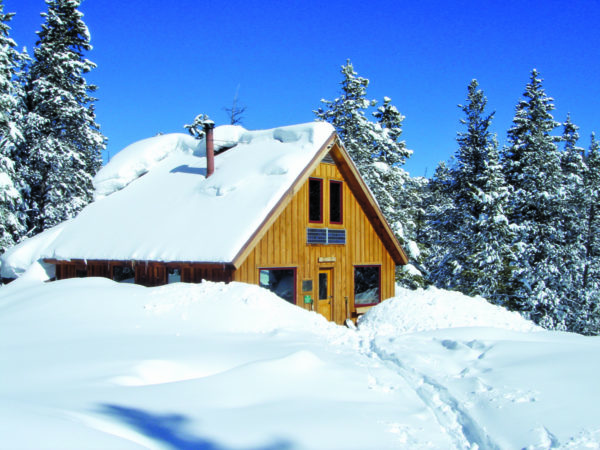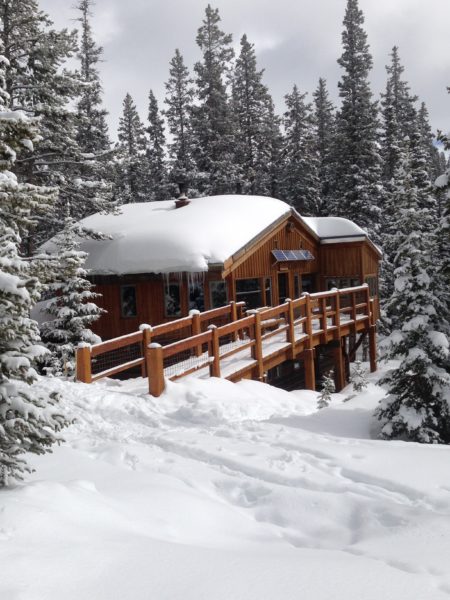
The McNamara Hut is located in Burnt Hole deep in the forest on the north side of Bald Knob. (Courtesy of Cornelia Carpenter)
Cabin fever has a secondary meaning in Colorado’s mountains, where adventurers flock to backcountry huts regardless of season.
With summer in the bag and the more popular winter months on the way, the pandemic hasn’t curtailed demand. But it has prompted the 10th Mountain Division Hut Association, the state’s most prominent hut manager, to make changes.
“I think the biggest challenge for us anytime — whether it’s COVID or not — is having an understanding of the expectations and preferences of our visitors,” said Ben Dodge, the association’s executive director. “We have gathered a lot of good information on what they prefer and what they expect, and we’re able to use that information to guide our management decisions.”
The nonprofit in Aspen finances, builds and manages 14 mountain huts in a network of 36 shelters stretching from Ashcroft to north of Vail. The structures range from 800 to 2,500 square feet and normally host between eight and 20 people for $33-$50 per head per night, Dodge said.
The association shuttered its huts from March 14 through mid-June, when many localities had stay-at-home orders. Now, huts can now only be used by a single party to prevent the spread of COVID-19 — a major departure from conventional times, when many explorers like to use the hut system to meet fellow adventurers.
Additionally, the association encouraged smaller groups, which normally book for one or two nights, by lowering its maximum to 12 from 16 for the winter and to eight from 12 over the summer.
The association relies on visitors to keep huts clean, though field staff goes in for inspection every seven to 10 days, Dodge said. Upon arrival and before checkout, guests must document a disinfection of the hut with provided cleaning equipment and by following a detailed checklist.
Dodge said the huts are cleaner than ever and lauded visitors’ responsibility for meeting the cleanliness standards.

The Betty Bear Hut is located in central Colorado, between the cities of Leadville and Aspen, near Hagerman Pass at 11,100 feet. (Courtesy of 10th Mountain Division Hut Association)
Survey feedback from guests on policies and procedures has been overwhelmingly positive — a sign of strong customer loyalty, Dodge said. New huts are added to the system every few years, and Dodge said there are new ones in the works, pending approval and proof that adding sites will be financially prudent.
“We certainly know one thing, and that is that there’s a lot more demand for the hut experience than there is supply,” Dodge said, adding that as the population of Colorado grows, demand will follow.
The association hosts 65,000 stays per year, though many are repeat users, Dodge said. The huts the association owns operate in a fall season running from Thanksgiving through April that makes up three-quarters of stays, and a summer season that stretches from July 1 through the end of September. Other huts in the system owned by different groups are open year-round.
It’s unclear how far capacity will drop this winter.
“We may see a reduction up to 25 percent, or none at all,” Dodge said. “We have reduced the maximum capacity at many of our huts by 25 percent. At the huts that we own and operate normally, they sleep 16 in the winter. We have reduced the maximum to 12. So, right out of the gate, at those 14 huts, I reduced our capacity by 25 percent.”
The organization has 15 employees, unchanged from past years, though it temporarily scrapped its volunteer program of about 100 to reduce variables during the pandemic.
Dodge said the 10th Mountain Division Hut Association saw a roughly 17 to 18 percent drop in headcount over the summer, though Dodge said there was an increase in funding from donors.
“I think many of us are choosing to support those organizations which we see as having value in this weird time,” Dodge said. “I’m not surprised by this, quite honestly. I think that the COVID situation has certainly highlighted a need to participate in our communities and support those efforts which we think are most important.”

The McNamara Hut is located in Burnt Hole deep in the forest on the north side of Bald Knob. (Courtesy of Cornelia Carpenter)
Cabin fever has a secondary meaning in Colorado’s mountains, where adventurers flock to backcountry huts regardless of season.
With summer in the bag and the more popular winter months on the way, the pandemic hasn’t curtailed demand. But it has prompted the 10th Mountain Division Hut Association, the state’s most prominent hut manager, to make changes.
“I think the biggest challenge for us anytime — whether it’s COVID or not — is having an understanding of the expectations and preferences of our visitors,” said Ben Dodge, the association’s executive director. “We have gathered a lot of good information on what they prefer and what they expect, and we’re able to use that information to guide our management decisions.”
The nonprofit in Aspen finances, builds and manages 14 mountain huts in a network of 36 shelters stretching from Ashcroft to north of Vail. The structures range from 800 to 2,500 square feet and normally host between eight and 20 people for $33-$50 per head per night, Dodge said.
The association shuttered its huts from March 14 through mid-June, when many localities had stay-at-home orders. Now, huts can now only be used by a single party to prevent the spread of COVID-19 — a major departure from conventional times, when many explorers like to use the hut system to meet fellow adventurers.
Additionally, the association encouraged smaller groups, which normally book for one or two nights, by lowering its maximum to 12 from 16 for the winter and to eight from 12 over the summer.
The association relies on visitors to keep huts clean, though field staff goes in for inspection every seven to 10 days, Dodge said. Upon arrival and before checkout, guests must document a disinfection of the hut with provided cleaning equipment and by following a detailed checklist.
Dodge said the huts are cleaner than ever and lauded visitors’ responsibility for meeting the cleanliness standards.

The Betty Bear Hut is located in central Colorado, between the cities of Leadville and Aspen, near Hagerman Pass at 11,100 feet. (Courtesy of 10th Mountain Division Hut Association)
Survey feedback from guests on policies and procedures has been overwhelmingly positive — a sign of strong customer loyalty, Dodge said. New huts are added to the system every few years, and Dodge said there are new ones in the works, pending approval and proof that adding sites will be financially prudent.
“We certainly know one thing, and that is that there’s a lot more demand for the hut experience than there is supply,” Dodge said, adding that as the population of Colorado grows, demand will follow.
The association hosts 65,000 stays per year, though many are repeat users, Dodge said. The huts the association owns operate in a fall season running from Thanksgiving through April that makes up three-quarters of stays, and a summer season that stretches from July 1 through the end of September. Other huts in the system owned by different groups are open year-round.
It’s unclear how far capacity will drop this winter.
“We may see a reduction up to 25 percent, or none at all,” Dodge said. “We have reduced the maximum capacity at many of our huts by 25 percent. At the huts that we own and operate normally, they sleep 16 in the winter. We have reduced the maximum to 12. So, right out of the gate, at those 14 huts, I reduced our capacity by 25 percent.”
The organization has 15 employees, unchanged from past years, though it temporarily scrapped its volunteer program of about 100 to reduce variables during the pandemic.
Dodge said the 10th Mountain Division Hut Association saw a roughly 17 to 18 percent drop in headcount over the summer, though Dodge said there was an increase in funding from donors.
“I think many of us are choosing to support those organizations which we see as having value in this weird time,” Dodge said. “I’m not surprised by this, quite honestly. I think that the COVID situation has certainly highlighted a need to participate in our communities and support those efforts which we think are most important.”

Leave a Reply